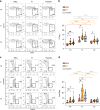Reduction in regulatory T cells in preterm newborns is associated with necrotizing enterocolitis
- PMID: 37344544
- PMCID: PMC10624602
- DOI: 10.1038/s41390-023-02658-3
Reduction in regulatory T cells in preterm newborns is associated with necrotizing enterocolitis
Abstract
Background: Despite multifactorial pathogenesis, dysregulation of inflammatory immune response may play a crucial role in necrotizing enterocolitis (NEC). Regulatory T cells (Tregs) are involved in immune tolerance early in life. We aimed to investigate the predicting role of Tregs in developing NEC in neonates at high risk.
Methods: We studied six newborns with a diagnosis of NEC (cases) in comparison with 52 controls (without NEC). We further classified controls as neonates with feeding intolerance (FI) and neonates without it (FeedTol). The rate of female and male neonates (sex defined as a biological attribute) was similar. We analyzed the blood frequency of Tregs (not overall numbers) at three time points: 0-3 (T0), 7-10 (T1), and 27-30 (T2) days after birth by flow cytometry. Neonates' sex was defined based on the inspection of external genitalia at birth.
Results: We observed, at T0, a significantly lower frequency of Tregs in NEC cases (p < 0.001) compared with both FI (p < 0.01) and FeedTol controls (p < 0.01). Multivariate analysis reported that the occurrence of NEC was independently influenced by Treg frequency at birth (ß 2.98; p = 0.039).
Conclusion: Tregs frequency and features in the peripheral blood of preterm neonates, early in life, may contribute to identifying neonates at high risk of developing NEC.
Impact: Regulatory T cells may play a pivotal role in regulating the immune response in early life. Reduction of Tregs in early life could predispose preterm newborns to necrotizing enterocolitis. Early markers of necrotizing enterocolitis are still lacking. We demonstrated a predicting role of assessment of regulatory T cells in the diagnosis of this gastrointestinal emergency. Early identification of newborns at high risk of necrotizing enterocolitis through measurement of regulatory T cells may guide clinicians in the management of preterm newborns in order to reduce the development of this severe condition.
© 2023. The Author(s).
Conflict of interest statement
The authors declare no competing interests.
Figures



